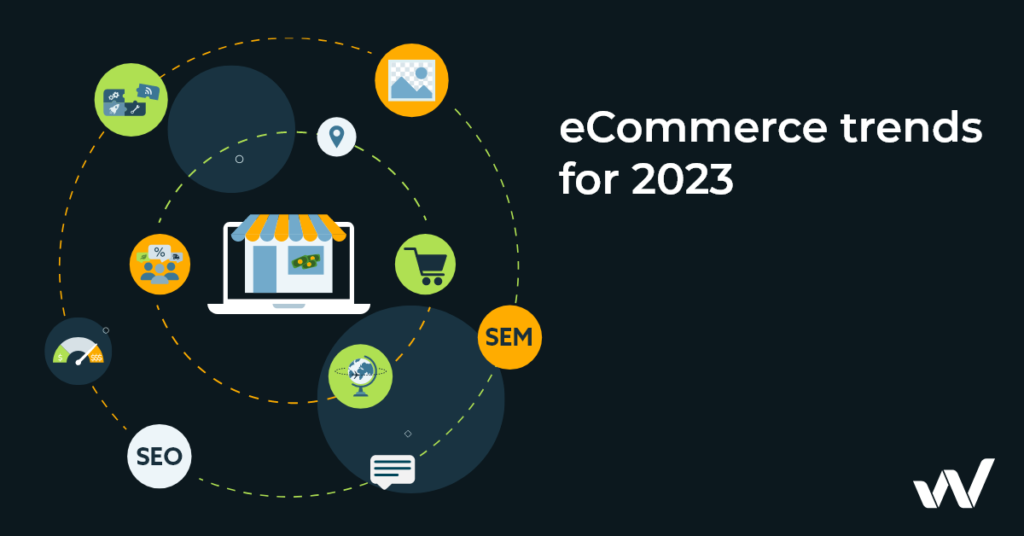Retailers must keep up with new trends to stay competitive due to changing consumer behaviour and rising technologies. Since 2020, both B2C and B2B stores have seen significant changes in in-person retail and online retail, and in 2023, people and technology will continue to shift the focus on what matters.
A company may stay relevant, outperform the competition, anticipate client wants, and explore new prospects by keeping up with the latest E-Commerce trends. Businesses can implement the best practices with E-Commerce marketing automation software.

The top e-commerce trends companies should follow listed below:
- Gather E-Commerce Data and Make Data-Driven Decisions
E-commerce data can provide valuable insights into customer behavior, sales trends, and overall business performance. By leveraging this data, you can make data-driven decisions that can help you optimize your e-commerce business. Here are some steps you can take:
Gather your data: Identify the key metrics and KPIs that are relevant to your goals. Some important metrics include website traffic, conversion rate, average order value, bounce rate, and customer acquisition cost. Use analytics tools like Google Analytics to collect and analyze this data.
Analyze your data: Once you have gathered your data, use data visualization tools to analyze it. Look for patterns and trends in your data to help you make informed decisions. For example, you may notice that certain products are selling better than others or that customers are dropping off at a particular stage of the checkout process.
Identify opportunities: Based on your analysis, identify opportunities for improvement. For example, you may decide to optimize your website for mobile users, create targeted marketing campaigns to reach new customers, or improve your checkout process to reduce cart abandonment.
Test and refine: Implement changes based on your insights and track their impact. Use A/B testing to experiment with different strategies and compare their performance. Continuously refine your approach based on your results.
By following these steps, you can leverage your e-commerce data to make data-driven decisions that can help you grow your business and achieve your goals.
- Omnichannel Shopping Experience
Omnichannel engagement is crucial for modern businesses as it offers a seamless and integrated customer experience across multiple touchpoints. By leveraging multiple channels such as SMS, email, push notifications, and WhatsApp, brands can connect with their customers in real time and provide personalized interactions that cater to their specific needs and preferences.
For instance, brands can use SMS for time-sensitive promotions or updates, email for newsletters and updates on new products, push notifications for reminding customers about their shopping carts, and WhatsApp for direct and personal customer support. Using these channels in a coordinated and consistent manner enhances the customer experience and helps build a strong brand image. It also helps in boosting customer loyalty and increases the chances of customer retention and repeat purchases. In today’s highly competitive market, providing a smooth and seamless omnichannel engagement is essential for businesses to stay relevant and retain their customers.
- Customers Love Personalisation
Segmentation is a powerful tool for personalizing messages in E-commerce as it enables businesses to tailor their communications to specific groups of customers based on their characteristics and behaviors. By segmenting their customer base, E-commerce businesses can gain a deeper understanding of their customers and create more relevant and personalized messages that resonate with them.
For example, businesses can segment their customers based on their purchase history, browsing behavior, and demographics. This information can then be used to send targeted messages to each segment, such as personalized product recommendations, promotional offers, and abandoned cart reminders.
Additionally, businesses can also segment customers based on their engagement level and send them relevant messages to keep them engaged with the brand.
- Customer Service is an Important Element
Regarding customer service in 2023, availability is key before and after the transaction. Your customer service must be attentive and efficient in resolving issues, but frequently, clients only need to know that someone is there to hear them out. Most issues may be resolved when a conversation starts with the consumer.
But expecting a person to be available to respond to inquiries all the time is unreasonable. Retailers need to investigate cutting-edge solutions like chatbots in this area. With the help of chatbots provided by E-Commerce marketing automation software, you can create a flow of responses that will make the customer feel like they have had a real interaction.
89% of consumers are more inclined to buy something else after having good customer service. If a company provides excellent customer service, customers are also ready to compromise for shipment delays.
- Brands are Leveraging Whatsapp for Sales
Brands are using WhatsApp as a sales channel by leveraging its reach and instant messaging capabilities to connect with customers and drive sales. One of the main ways they are doing this is through the creation of WhatsApp business accounts, which allow them to send promotional messages, updates on new products and offers, and answer customer inquiries in real-time.
Additionally, businesses can create catalogs or menus on WhatsApp, showcasing their products and services, and allowing customers to place orders directly through the platform. Brands can also use WhatsApp to share product images and videos, making it easier for customers to make informed purchasing decisions.
Another way brands are using WhatsApp for selling is through the implementation of chatbots.
- Post-Purchase Engagement for Enhancing Customer Experience
Post-purchase engagement is an important aspect of customer experience in e-commerce as it helps to build a strong and lasting relationship between the brand and the customer.
Here are a few ways that post-purchase engagement can boost customer experience in e-commerce:
Order Follow-Up: Following up with customers after an order has been placed can provide reassurance and build trust. Brands can use automated systems to send order confirmations, shipping updates, and delivery notifications to keep customers informed and up-to-date.
Product Feedback: Asking for customer feedback after a purchase provides valuable insights into their experience and can help businesses improve their offerings. Feedback can be solicited through surveys, email, or even through social media.
Loyalty Programs: Offering loyalty programs and rewards can incentivize repeat purchases and encourage customer loyalty. Brands can use post-purchase engagement to promote these programs and keep customers interested.
By engaging with customers post-purchase, e-commerce businesses can enhance the customer experience and increase customer satisfaction, leading to repeat purchases and long-term loyalty.
- The Focus Is on Sustainability and the Environment
Our daily lives now include a larger portion of environmental issues. Customers are paying attention, so retailers should take the time to look out for ethical suppliers for their goods.
According to Statista, 42% of online customers would pick a company that uses sustainable packaging over one that doesn’t.
In 2023, reducing your company’s carbon footprint is a good message to spread and one that customers will be interested in. Major businesses, including McDonald’s, Adidas, and Zara, have recently made significant attempts to cut back on the use of plastic in their operations.
- More Payment Options at Checkout
In 2023, retailers who don’t provide a range of payment choices risk losing even more customers.
Customers utilise various payment providers based on where and how they shop due to the growth of social commerce and mobile purchasing. Retailers must determine if they are fully prepared. For instance, Gen Z makes purchases considerably differently from earlier generations.
The goal is to provide quick checkout options without compromising security through E-Commerce marketing automation software. By 2026, it’s anticipated that more than 60% of people will use digital wallets. Do you allow customers to pay with popular digital wallets like PayPal, Apple Pay, and Google Pay? If not, it might be wise to change your mind.
- Data Protection and Security Should be Prioritised
Customers are prepared to divulge personal information if it results in a better-customised experience, but it shouldn’t come at the expense of their data’s security. Customers want to make secure online purchases in 2023.
A unique SSL certificate that prefixes your site URL with https is required for your website to be completely safe. This assures clients that their personal information, including credit card information, will be handled securely and confidentially.
Retailers should consider allowing consumers to check out as guests for individuals who don’t want to give up their sensitive personal data. By 2025, the market for e-commerce fraud detection and prevention is anticipated to double.
Conclusion
The first hurdle is setting up your internet store; the second is expanding it. To beat the competition and make your store stand out, you should consider implementing some of these trends into your online plans for 2023.
You don’t have to invest significantly in something you’re not confident will succeed. Try to start small with a limited number of clients and then iterate from there.
The one overarching trend that all others fit into in some way is customer experience. You need to deliver the best experience for your shoppers, whether having a site that looks great on every device, giving them enough methods to complete their purchase or offering full transparency and flexibility with their delivery options.
Everything you do in 2023 should be to enhance the customer experience with E-Commerce marketing automation software. It’s the only way your business can stand out in the busy online retail industry.







Leave a Comment
You must be logged in to post a comment.